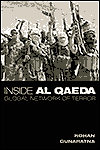|
|
The Taliban Rises - Again
Syed Saleem Shahzad
Correspondent, Asia Times
The
Taliban
movement has widely regrouped itself in Afghanistan, mostly along the
Pakistan-Afghanistan border areas. The social, geographical and
political characteristics of the whole of this tribal belt favor the
Taliban fighters, and the Pakistani, US and Afghan authorities just
cannot control the Taliban in this specific region.
The guerilla war in Afghanistan has really taken shape since October
2002. Earlier, between October 7, 2001, and December 2001, heavy US
precision bombing had coerced the Taliban to leave their controlling
positions and disperse to places where they could find a shelter.
Mullah Omar's
decision of retreat from Kabul and Kandahar forced most of his
commanders to hide themselves in Pakistani tribal areas. Ordinary
Taliban foot soldiers easily melted into the civilian Afghan population.
Several replaced their black turbans from Pakhool and joined the new
Afghan administration. Many chose to go back to their tribes and resumed
a routine life as ordinary citizens. However, the Taliban took only a
few months to prove that US claims of destroying their network were
wrong.
By October 2002, the Taliban had widely regrouped. Most of their top
commanders including Mullah Akthar Usmani, Mullah Dadullah and Maulana
Jalaluddin Haqqani restored their links and were subsequently able to
contact their followers, restoring the 'struggle'. Their messages,
circulated through pamphlets and audio tapes, gave a general call for
jehad against the occupying foreign forces. In the succeeding months,
the Taliban established a regular relationship with Gulbuddin
Hekmatyar's Hizb-I-Islami Afghanistan (HIA), once the largest militant
group fighting against the former USSR. Hekmatyar, a former student
leader of the Engineering University of Kabul was also nominated an
interim Prime Minister in the Professor Burhanuddin Rabbani-led
Coalition government in 1993, which was finally booted out by the
Taliban. The Taliban had issued a fatwah (religious decree) for
the assassination of Gulbuddin Hekmatyar in the mid-1990s, as they
considered him responsible for bloodshed among the Afghans to fulfill
his greed for power. As a matter of record, it is useful to note that,
despite the current and congenial ties between the Taliban and the HIA
and the joint struggle they have launched against the US and her allies,
the fatwah was never taken back.
Regular contacts and coordination between the Taliban and the HIA were
eventually transformed into an alliance, which was named 'Saiful
Muslemeen'. The remnants of the
Al Qaeda
also became part of this network. According to sources, after the
formation of this group, all three constituents have agreed on a single
and integrated strategy in which finance and human resources would be
shared in future coordinated operations.
At present, the resistance movement has chosen Zabul, Spin Boldak and
Hilmand as the areas where they have to re-establish their authority.
These districts are situated all along the mountainous terrain, which
best serves a guerilla campaign. This terrain leads to safe routes that
go across areas demarcated by the Durand Line, which separates Pakistan
from Afghanistan, and exists only on the map. Practically, there is no
clear demarcation of the border, and there are dozens of villages
located on the Line, part in Afghanistan and part in Pakistan. The
people on both sides of the notional Durand Line belong to the same
tribes (the Noor Zai and the Achakzai) and have traditionally moved
freely on both sides of the divide for centuries. These are the
circumstances that make it possible for the Taliban to attack their
targets on Afghan soil, using the mountainous terrain to strategic
advantage, and then melting into the villages in the Pak-Afghan border
areas. The Pakistani tribal areas, consequently, provide natural
strategic depth to the Taliban fighters.
The people who live all around the Chaman area on the Pakistani side of
the divide are extremely religious, and numerous madrassahs (Islamic
seminaries, numbering approximately 200) are the ideological centers of
the Taliban movement. The location of these seminaries is, again,
problematic, since they exist along the line where a clear demarcation
of Pakistani and Afghan territory is impossible.
With these key factors complementing their modus operandi, the Taliban
have established their writ in Zabul, Hilmand and Spin Boldak. The US
Forces in Afghanistan are unwilling to take casualties, and consequently
only provide limited aerial support to the Afghan Army in their
operations in the area. On occasion, some US soldiers have been sent in
to reinforce the Afghan militia's line of defense, but these soldiers
rarely participate in the action and generally limit their role to
guiding the operations. This has tended to demoralize the Afghan
administration and Forces, and they now increasingly accept the presence
of the Taliban in these three districts. Although the Taliban is yet to
appoint its own administration in these areas, they have established a
kind of de facto rule and a strong presence in the mountainous terrain
around the area. The local administration is aware that, if they act
against the will of the Taliban, the consequences would be extreme.
In Khost, Paktia, Paktika and Gazni, the Taliban seek to inflict terror
on the US Forces. They do not control any significant areas in these
provinces, but gather in the Northern and Southern Waziristan area of
Pakistan as well as in the Kurram Agency to execute strikes across the
border and then retreat to the relative safety of Pakistani territory.
Once again, they hide out in the mountains in areas where the nebulous
Durand Line separates Pakistan from Afghanistan.
There is a long-standing tradition, within this specific area, of the
local Waziri tribes who live on both sides of the Pakistan-Afghanistan
border, to move across the divide for trade. They move as a Lashkar
(group) and always carry guns and ammunition with them. For centuries,
they have never been prevented from free movement in the area, and no
one has ever asked them for travel documents. The result is that neither
the Afghan security guards nor the Pakistanis can make out the
difference between these tribal groups and the movement of the Taliban.
US Forces have tried to chase the Taliban operating in this area on
several occasions. In rare cases, US Forces successfully track them
crossing into Pakistani areas. By and large, however, they generally
hide in the mountainous terrains and, when the dust settles, cross over
into the Pakistani tribal belt as a tribal Lashkar to live a routine
life for a few weeks, while they plan another mission in Afghanistan.
The Taliban, HIA and Al-Qaeda have, so far, been using the Kunar Valley
as their strategic reserve where they have protected their manpower, but
where they do not engage in any violent activities. The local
administration is dominated by Jehadi commanders who are loyal to the
HIA and the Taliban, and these groups choose not to bother them with
their guerilla attacks. A similar, though not identical, situation
prevails in Jalalabad, where the HIA has reportedly established camps,
and a kind of truce exists between the local administration and the
guerillas. They cooperate with each other and there is an agreement
that, if the resistance takes shape in eastern Afghanistan, the present
administration would surrender to the emerging Force in accordance with
the Afghan custom, and would not engage the emerging Force in a fight.
Within this context, the recent Pakistan Army operation in Bannu near
North Waziristan was conducted because the US intelligence apparatus was
had secured information about the presence of an important Al-Qaeda
operative of Iraqi origin (Abdul Hadi Al-Iraqi), along with several
other Arab Afghans and Pakistani militants. However, the intense
reaction of the tribals caused the troops to halt abruptly, and they
were sent back to their old positions. According to sources, the Al
Qaeda operatives never dwell in Wana or Miran Shah, the headquarters of
South and North Waziristan, respectively, but always stay in the no
man's land near the Pakistan-Afghanistan border, with supporters in
Pakistan sending them medical and food supplies, as well as requirements
of daily life. In effect, in this area, their presence is yet to be
significantly challenged.
Courtesy:
South Asia Terrorism Portal |


